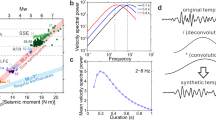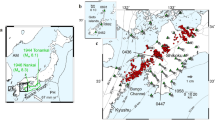Abstract
Deep tremor in subduction zones is thought to be caused by small repeating shear slip events on the plate interface with significant slow components1,2,3,4. It occurs at a depth of about 30 kilometres and provides valuable information on deep plate motion and shallow stress accumulation on the fault plane of megathrust earthquakes. Tremor has been suggested to repeat at a regular interval1,2, migrate at various velocities4,5,6,7 and be modulated by tidal stress6,8,9. Here I show that some time-invariant interface property controls tremor behaviour, using precise location of tremor sources with event duration in western Shikoku in the Nankai subduction zone, Japan. In areas where tremor duration is short, tremor is more strongly affected by tidal stress and migration is inhibited. Where tremor lasts longer, diffusive migration occurs with a constant diffusivity of 104 m2 s−1. The control property may be the ratio of brittle to ductile areas, perhaps determined by the influence of mantle wedge serpentinization on the plate interface. The spatial variation of the controlling property seems to be characterized by striations in tremor source distribution, which follows either the current or previous plate subduction directions. This suggests that the striations and corresponding interface properties are formed through the subduction of inhomogeneous structure, such as seamounts, for periods as long as ten million years.
This is a preview of subscription content, access via your institution
Access options
Subscribe to this journal
Receive 51 print issues and online access
$199.00 per year
only $3.90 per issue
Buy this article
- Purchase on Springer Link
- Instant access to full article PDF
Prices may be subject to local taxes which are calculated during checkout




Similar content being viewed by others
References
Obara, K. Nonvolcanic deep tremor associated with subduction in southwest Japan. Science 296, 1679–1681 (2002)
Rogers, G. & Dragert, H. Episodic tremor and slip on the Cascadia subduction zone: the chatter of silent slip. Science 300, 1942–1943 (2003)
Shelly, D. R., Beroza, G. C., Ide, S. & Nakamula, S. Low-frequency earthquakes in Shikoku, Japan, and their relationship to episodic tremor and slip. Nature 442, 188–191 (2006)
Shelly, D. R., Beroza, G. C. & Ide, S. Non-volcanic tremor and low-frequency earthquake swarms. Nature 446, 305–307 (2007)
Ito, Y., Obara, K., Shiomi, K., Sekine, S. & Hirose, H. Slow earthquakes coincident with episodic tremors and slow slip events. Science 315, 503–506 (2007)
Shelly, D. R., Beroza, G. C. & Ide, S. Complex evolution of transient slip derived from precise tremor locations in western Shikoku, Japan. Geochem. Geophys. Geosyst. 8, Q10014 (2007)
Ghosh, A. et al. Tremor bands sweep Cascadia. Geophys. Res. Lett. 37 L08301 10.1029/2009GL042301 (2010)
Nakata, R., Suda, N. & Tsuruoka, H. Non-volcanic tremor resulting from the combined effect of Earth tides and slow slip events. Nature Geosci. 1, 676–678 (2008)
Rubinstein, J. L., Rocca, M. L., Vidale, J. E., Creager, K. C. & Wech, A. G. Tidal modulation of nonvolcanic tremor. Science 319, 186–189 (2008)
Hirose, H. & Obara, K. Repeating short- and long-term slow slip events with deep tremor activity around the Bungo channel region, southwest Japan. Earth Planets Space 57, 961–972 (2005)
Ide, S., Shelly, D. R. & Beroza, G. C. The mechanism of deep low frequency earthquakes: further evidence that deep non-volcanic tremor is generated by shear slip on the plate interface. Geophys. Res. Lett. 34 L03308 10.1029/2006GL028890 (2007)
Ide, S., Beroza, G. C., Shelly, D. R. & Uchide, T. A scaling law for slow earthquakes. Nature 447, 76–79 (2007)
Schwartz, S. Y. & Rokosky, J. M. Slow slip events and seismic tremor at circum-pacific subduction zones. Rev. Geophys. 45 RG3004 10.1029/2006RG000208 (2007)
Rubinstein, J. L., Shelly, D. R. & Ellsworth, W. L. in New Frontiers in Integrated Solid Earth Sciences, International Year of Planet Earth 287–314 (Springer Science and Business Media, 2010)
Brown, J. R. et al. Deep low-frequency earthquakes in tremor localize to the plate interface in multiple subduction zones. Geophys. Res. Lett. 36 L19306 10.1029/2009GL040027 (2009)
Matsubara, M., Obara, K. & Kasahara, K. High-VP/VS zone accompanying non-volcanic tremors and slow-slip events beneath southwestern Japan. Tectonophysics 472, 6–17 (2009)
Maeda, T. & Obara, K. Spatio-temporal distribution of seismic energy radiation from low-frequency tremor in western Shikoku, Japan. J. Geophys. Res. 114 B00A09 10.1029/2008JB006043 (2009)
Shiomi, K., Obara, K. & Sato, H. Moho depth variation beneath southwestern Japan revealed from the velocity structure based on receiver function inversion. Tectonophysics 420, 205–221 (2006)
Miyazaki, S. & Heki, K. Crustal velocity field of southwest Japan: Subduction and arc-arc collision. J. Geophys. Res. 106, 4305–4326 (2001)
Seno, T. & Maruyama, S. Paleogeographic reconstruction and origin of the Philippine Sea. Tectonophysics 102, 53–84 (1984)
Takahashi, M. Tectonic development of Japanese Islands controlled by Philippine Sea plate motion. J. Geog. 115, 116–123 (2006)
Rubin, A. M., Gillard, D. & Got, J.-L. Streaks of microearthquakes along creeping faults. Nature 400, 635–641 (1999)
Obara, K. & Hirose, H. Non-volcanic deep low-frequency tremors accompanying slow slips in the southwest Japan subduction zone. Tectonophysics 417, 33–51 (2006)
Katsumata, A. & Kamaya, N. Low-frequency continuous tremor around the Moho discontinuity away from volcanoes in the southwest Japan. Geophys. Res. Lett. 30 10.1029/2002GL015981 (2003)
Obara, K., Tanaka, S. & Maeda, T. Reevaluation of nonvolcanic tremor activity based on the hybrid method. Eos 90 (Fall Meet. Suppl.), abstr. T11C–1835 (2009)
Ide, S. A Brownian walk model for slow earthquakes. Geophys. Res. Lett. 35 L17301 10.1029/2008GL034821 (2008)
Hyndman, R. D. & Peacock, S. M. Serpentinization of the forearc mantle. Earth Planet. Sci. Lett. 212, 417–432 (2003)
Wada, I., Wang, K., He, J. & Hyndman, R. D. Weakening of the subduction interface and its effects on surface heat flow, slab dehydration, and mantle wedge serpentinization. J. Geophys. Res. 113 B04402 10.1029/2007JB005190 (2008)
Kato, A. et al. Variations of fluid pressure within the subducting oceanic crust and slow earthquakes. Geophys. Res. Lett. 10.1029/2010GL043723 (in the press)
Kodaira, S., Takahashi, N., Nakanishi, A., Miura, S. & Kaneda, Y. Subducted seamount imaged in the rupture zone of the 1946 Nankaido earthquake. Science 289, 104–106 (2000)
Acknowledgements
I thank G. C. Beroza for many useful comments. Comments from K. Wang and discussions with S. Yoshioka, T. Hori, B. Shibazaki, R. Ando and A. Namiki were helpful. This work is supported by JSPS KAKENHI (20340115) and MEXT KAKENHI (21107007). The figures were prepared using the Generic Mapping Tool (P. Wessel and W. H. F. Smith, 1998).
Author information
Authors and Affiliations
Corresponding author
Ethics declarations
Competing interests
The author declares no competing financial interests.
Supplementary information
Supplementary Figure
This file contains Supplementary Figure S1. This file was uploaded on 09 August 2010. (PDF 395 kb)
Rights and permissions
About this article
Cite this article
Ide, S. Striations, duration, migration and tidal response in deep tremor. Nature 466, 356–359 (2010). https://doi.org/10.1038/nature09251
Received:
Accepted:
Issue Date:
DOI: https://doi.org/10.1038/nature09251
This article is cited by
-
Segmentation characteristics of deep, low-frequency tremors in Shikoku, Japan using machine learning approaches
Earth, Planets and Space (2023)
-
A review on slow earthquakes in the Japan Trench
Progress in Earth and Planetary Science (2023)
-
Spatiotemporal evolution of tremor activity near the Nankai Trough trench axis inferred from the spatial distribution of seismic amplitudes
Earth, Planets and Space (2022)
-
Forecasting tectonic tremor activity using a renewal process model
Progress in Earth and Planetary Science (2022)
-
Spatio-temporal distribution of shallow very-low-frequency earthquakes between December 2020 and January 2021 in Kumano-nada, Nankai subduction zone, detected by a permanent seafloor seismic network
Earth, Planets and Space (2022)
Comments
By submitting a comment you agree to abide by our Terms and Community Guidelines. If you find something abusive or that does not comply with our terms or guidelines please flag it as inappropriate.



